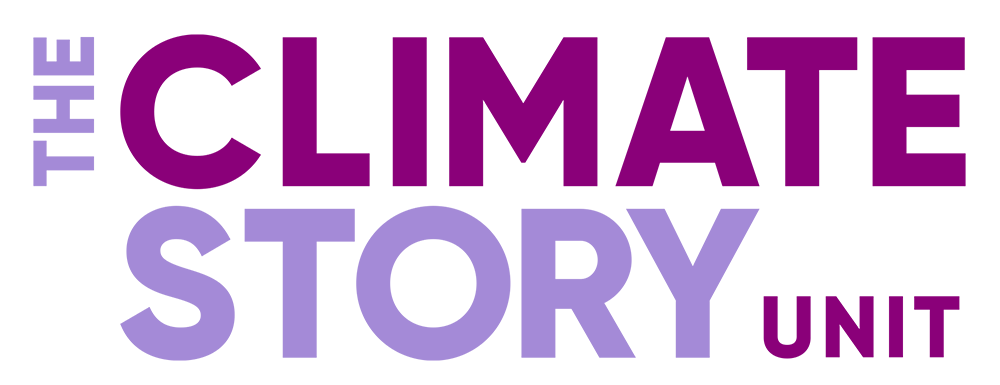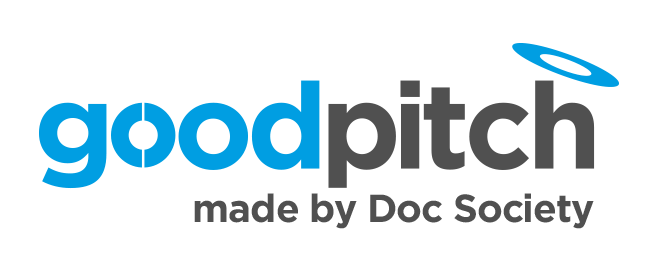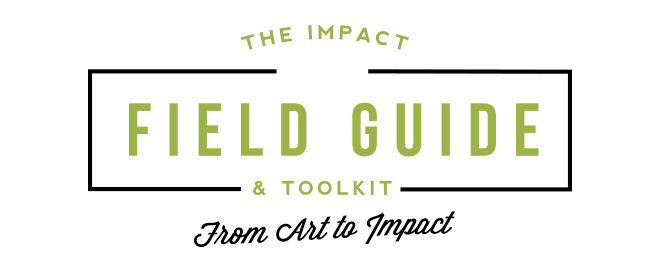Visions for the future of documentary
March 5, 2025
@ Australian International Documentary Conference (AIDC), Melbourne, Australia

At the Australian International Documentary Conference (AIDC) in March, Unquiet Collective’s Alex Kelly and Doc Society’s Hollie Fifer facilitated a visioning session for the future of media. This was a space for documentary makers and experts to imagine a transformed information ecosystem.
Five visionaries travelled from the future to share back to the audience stuck in 2025, the steps society took to get to their future.
Throughout the session we asked the live audience a few questions via the Mentimeter to gauge their feelings and roles in documentary.
The session revealed a collective hunger for systemic change in public interest media. Participants recognised everyone knew what was needed and the step necessary to get there.
Let’s explore these collective dreams with some excerpts from each vision.
Welcome to the revolution!
Featuring:
Kimberley Benjamin (Yawuru, Bardi and Kija) - Researcher, Writer, Director and Story Producer of Our Medicine (NITV), Back to Nature (ABC) & Re-imagining Our Futures: birthing’ (Channel 10/Paramount)
Ian Darling - Director of The Pool (SFF), The Final Quarter (Amazon), Paul Kelly: Stories of Me (ABC) and Executive Director of Shark Island Institute and Chair of Shark Island Foundation.
Dr. Eliorah Malifa - Co-Director of Pasifika Film Festival, Climate Story Lab Pacific & Senior Program Manager, the Department of Pacific Affairs at Australian National University
Mitch Nivalis - Director of Equal the Contest (SBS, Amazon) and The Gender Game (in development)
Prash Naik - Co-Founder of Creators Counsel & General Counsel to Doc Society
Hosted by Alex Kelly, Unquiet Collective & Hollie Fifer, Doc Society

KIMBERLEY BENJAMIN (Yawuru, Bardi and Kija) - Researcher, Writer, Director and Story Producer
I extend deep respect to Elders and sovereign peoples whose Country this is. This place has been home to staunch activism where movements and inspiration for others have been born out of. I hope your land back initiatives are full with wealth for people and Country.
Can you close your eyes for me? – take a deep breath in – exhale - can you smell that? the air smells salty hey, must be high tide soon, I hear the walga walga, salmon are running, the wattle is starting to bloom, the ground is sizzling from the heat, it’s always been hot up here. …even in 2091. You can open your eyes now.
Yawuru Djugun Country is pretty special isn’t it. Rubibi or its former name ‘Broome’ has always been special to me and my family. Damn - I haven’t used its coloniser name in forever, ‘Broome’. I still fish off my Nanna’s famous fishing spot – Bungadoos’ Rock. I don’t think I could ever catch as many fish as my Nanna did though. I never met her but I know her – she’s still with us, she lives on through the faces of my nephews and nieces and the stories my mum and aunties have told me.
Plus our local First Nations media org, Goolarri… they’ve been around since 1991, the 90’s!! They’re celebrating their 100th year anniversary this year! Biggest celebrations I tell you what. Well, Goolarri set up this massive archive to honour all our old people.
Stories, photos, recordings, materials, newspaper clippings – lol newspapers remember those? Government documents, even a few of my own documentaries, the lot, they’re all in there and accessible for families whenever they need. Digital Sovereignty, in our own hands. It’s given our community this strong sense of connection to each other, just knowing our old people are never forgotten.
Since the government implemented a roundtable of Elders to lead the Country, communities are thriving, people feel safe, they feel a part of the ecosystem of the community, they feel loved. Remember the police? Well they’ve been abolished, along with other carceral systems – all forms of prisons, gone. And it wasn’t just sacking the cops and demolishing the buildings. It was rethinking who we go to when someone’s been hurt. Those buildings, police stations, prisons, detention centres they got turned into libraries and free supermarkets, language centres, free childcare centers, some of the land was regenerated with native plants to what Country would have looked like all those years ago. In Rubibi, the jila, the natural spring that was cemented over with a prison 100’s of years ago, the water returned only last year. That was special. The funding and wages of these old systems of policing were redistributed to community-controlled safety and wellbeing centres. Staff were retrained in Indigenous principles of mutual aid.
Recently, I did a global First Nations collaboration with our friends in Alberta, Canada. We co-produced a series on this type of transformative justice and best practice in our First Nations communities. I was involved because Rubibi, my home was one of the communities chosen as a best practice model. Of course we’re not perfect as a community, we make mistakes all the time. I make mistakes all the time. But there’s no punishment, there’s growth, there’s generative conflict, we need each other, we show up, we’re accountable to one another in our community.
All of this has been integrated as established protocols in the film industry. Anti-racism training is at the helm of it all. Country is centred and cannot be exploited for the purposes of a film production. Films are made with intention and collaboration from the conception of the idea. There are systems in place where if conflict occurs, repair and healing is prioritised above anything else.
There is no rush to finish a project on a linear timeline… people understand storytelling in a cyclical sense, just like the way my Aunty will return to the same story again and again until it is ingrained in my heart and liyan, spirit, forever.
When you feel like it, take a deep breath and exhale.
This future is possible. We are the ones we’ve been waiting for.

IAN DARLING - Documentary Director and Executive Director of Shark Island Institute and Chair of Shark Island Foundation.
It is 2035. I’m coming to you from a wonderful portal called Middle-World. Middle-World is a place where we have found respectful engagement, deep listening and even consensus. Where documentaries are being watched by a much larger audience, where the funding pool has expanded, where philanthropic grants for documentary has increased, and where real and lasting impact is finally happening. All as a result of the incredible power, leverage and influence of feature documentaries.
We now understand that finding the middle ground is the only way forward for long term sustainable change. We have finally learnt the art of listening to each other, understanding things from the other's perspective, and not shouting across tables or in social media. Ha, remember that shit world of social media!
Cinemas now in 2035 dedicate a permanent screen in their complexes exclusively to documentary and allocate prime slots to docs (not the 10am Monday morning slot). They make a commitment to build audiences, not cut them just as word of mouth is taking effect in the 2nd week of a screening run - and they now run documentaries for a minimum of 2 months. The results have been spectacular. At least one screening a week is accompanied by a Q&A with the filmmakers, and the players in the issues around the film. Audiences love it.
The public broadcasters also saw their social responsibility to the community. The ABC in 2035 now programs a full feature documentary at 7.30pm every Sunday night, and SBS does the same at 7.30pm on Tuesdays - every week of the year. It's been transformative for audiences, and viewing patterns have changed accordingly. They had the confidence to build ratings over a full 10 year period, and in the initial years as the audience was building, didn't run away from the lower ratings, knowing that over 10 years, their weekly documentary slots would be amongst the highest in their slate. What vision and courage those mighty broadcasters had back then in 2025.
The streamers now promote documentary on 2 levels. The corporations and billionaire owners finally remembered that they all began their love of film because they all grew up watching films in cinemas. These same people and their organisations are now the main funders of cinemas - they own and maintain many of them, and today in 2035, every film they stream is now given a slot at the cinema first. Again for a minimum of 2 months. Today, the streamers too realise that the most powerful way to see film, especially documentary, is as a shared experience first. What a joy it is to go to the DocPlay cinema complex here in Melbourne. A cinema complex that plays only documentaries, 24 hours a day. The lines around to block are huge!
The government funding bodies have equally realised the importance of real storytelling as both a social and economic model. After years of government cutbacks and declining funding to documentaries, their primary focus is now documentary! Over the last decade they saw that feature documentary has been the most cost effective programming of all - a full 2 hours of pure entertainment for only $1.5m. Far more documentary films can be made with the scarce resources at their disposal, and the importance of these to the national conversation is more important than it ever has been. What visionaries you have been!
Everyone is sharing their real social responsibility - and finally the documentary sector is viable and sustainable.

DR ELIORAH MALIFA - Co-Director of Pasifika Film Festival & Climate Story Lab Pacific
In 2035, the 2050 Strategy for the Blue Pacific Continent, with all its semi neo-colonial leanings, has forged ahead in three of its six political commitment areas. These are:
- That we “guarantee the future of our children”
- That we “ensure a well-connected region”
- We are well on our way to achieving these by commitment to the third political area of "acceleration of economic growth aspirations".
In my 2035, these economic growth aspirations have been accelerated in the Pacific, because Pacific governments and policy makers have reprioritised creative industries and decided to bite the bullet and commit to the long-term investment in screen and film industry.
How did we get here? After the 2024 Festival of Pacific Arts and Culture in Hawaii, filmmakers from the region started dialogues about ways to influence regional policy making around a Pacific film and television industry.
Questions like: How can we make the 2016 scoping paper that the Commonwealth Foundation wrote, looking into a Pacific film and television industry, actually happen? And what was the point of the paper, what came of it? How do we take these reports, and proposals that are so common in the Pacific and enact them in a sustainable way? Lastly, how do we make Pacific governments understand how the long term investment into screen industry could eventually benefit the Pacific?
What did we do? We started our own Pacific network of filmmakers and lobbied to get ourselves on the agenda for the annual Council of Pacific Arts and Culture Meeting.
By 2026, we were a recognised association of Pacific screen practitioners. By 2027, we had developed a Pacific film festival circuit that was recognised internationally. In 2035, we have 10 of our network countries signed up to contribute to a regional fund that funds 2 short films per year, and 1 feature film biannually. 7 of those countries have also agreed to fund 1 national documentary feature every 3 years and our network has partnered with the World Bank, Pacific Islanders in Communication, Pacific Island Screen Artists and the UNFCCC to fund 2 regional documentaries biannually (one of which will be climate related). We have convinced the Australia Pacific Training Coalition (APTC) which provides vocational training all over the region, to include camera operating in their curriculum. And Dwayne ‘The Rock’ Johnson and Samoan showrunner Dana Ledoux Miller, have agreed to pilot a small film institute for a 5 year period in Samoa.
By working towards and lobbying for these pathways in the Pacific, we've created jobs and industry in the region. Jobs that young people can easily occupy for companies that Pacific millennials are in 2025, already spearheading in the Pacific. We’re taking ownership of our stories, both by telling them and ensuring that we own the intellectual property and any income associated with it. The end game of our advocacy, is that the global north of screen will not be as extractive of the Pacific as it is in 2025, and to a lesser extent 2035.
- We pay our own crew and cast to work on our own projects
- And when foreign projects are on island, we’ve developed policy to ensure 70% of their crew is local, and the shoot engages with 100% local business as part of any shoots ancillary needs.
This work is disrupting the ongoing narrative about the Pacific.
- Pacific women are not as invisible as we used to be, you could say that the hard launch for this could’ve been Moana, but our stories are a little more plentiful in 2035, we’re smart, we’re hot, we’re awkward, we’re queer, we make mistakes, we’re neurodivergent, take your pick.
- Pacific people do not only predominantly exist as athletic men, or as jovial people, dancing, singing and performing.
- In climate dialogues, we’ve gone from being ‘vulnerable’ to being resilient and resistant – and strong.
- We've taken documentary to be our own.
Truthfully when I said at the top that I was glad I found you guys, my travel through time and space had stopped in the 1930s first and ethnographic film was rife in the Pacific, so it was nice to jump back to 2025, where things have moved. And in a region where we don’t always as Pacific people think of ourselves as documentary filmmakers, because it has often been a vehicle that has othered us, its become a necessary storytelling vehicle, because our stories are now ours and we are standing at the front of them. For example, the documentary one of us made about the Papua New Guinean rugby league club during their debut year in 2028. They won the premiership in 2029 😊.

MITCH NIVALIS - Photographer, Documentary Director and Gender Inclusion Advocate
In Australia, the film industry recognised what a disaster it would be to lose diversity and stepped in. You all stepped in and led change.
We listened and learnt - finally! - from First Nations people and we understood our stories needed to guide us, instead of industry and money guiding the stories. We got on the front foot of AI technology. Hackers released AI from Big Tech, retrained it with true diversity and now, in 2035, documentary is thriving. All storytellers need is a computer and they can narrate their stories into AI and it samples landscapes and weather and faces and emotions and converts stories into beautiful and rich documentaries. Everyone has access to allow their stories to be told. And these stories are open source. People can log in to the global story database and share their lived experience to inform documentaries in development, so it’s never just one perspective. And we’ve got authenticity barometers in place, so no one can fictionalise their accounts, twist stories or use them to hurt other people. Filmmaking is no longer an industry designed to make money for a few large corporations, while filmmakers and those who’s stories are being told struggle.
And, I don’t want to break your brains too much in one day, but I’ve gotta say, even this is pretty archaic. In fact, technology has just been standing in, waiting for us to be ready to use the power of our minds. One day, we’ll be transferring our stories to each other through the mental field and something powerful happens in this moment. When everyone has access to each other’s stories, we begin to understand each other. Empathy grows. Beyond 2035, there are so many stories being told accessibly that no-one feels alone. Everyone recognises we are all one and our differences join together to make us whole.
I’m here to tell you, the future is waiting. It’s time to start dismantling the structures that are keeping our stories from being told. Quotas are a good first step for ensuring diverse stories are being commissioned. But that’s just a start. It’s time to start removing the gatekeepers and embracing the future of storytelling. In the future, we’re all united, because in the future we are all made visible.

PRASH NAIK - Media Lawyer & Co-Founder of Creators Counsel
By 2035 over 150 countries including Australia now provide statutory protection and recognition of public interest media. Statute now recognises that it plays an essential role in safeguarding a healthy democracy as an antidote to misinformation and disinformation.
Public interest media takes many forms, but at its vanguard are social impact documentaries because of their power to engage audiences and drive real social change.
How is this Funded?
In 2035 public interest media funds exist in all member states in the global north and south.
In Australia, this is funded in part by the largest global streaming platforms who are subject to an annual 20% levy on their gross revenue. This is designed to address the virtual absence of such content on their platforms.
The fund also receives additional monies generated from a digital platform levy on big tech. This is in recognition for the part Big Tech has played in contributing to the misinformation and disinformation culture.
The Australian Public Interest Media Fund then allocates around $AUD100m a year to social impact documentaries by way of development and production grants as well as funding impact campaigns and marketing.
How are Films Distributed?
In 2035, a global distribution network called PAN (taken from the Greek prefix meaning universal inclusiveness) now exists. It operates as a non-profit under a single banner and is funded by member states.
It is a collective which brings together film festivals, art-house theatres, existing curated platforms, brand-funded distribution and direct-to-fan platforms. It also includes a community social media platform to market films and build engagement through impact campaigns.
It uses shared data analytics and AI algorithms to target audiences through existing social media, its own platform and other targeted marketing.
By working together, the collective has nurtured and built up a global community of filmmakers, audiences and impact campaigners that support one another. It allows scale, a one-stop shop for audiences and strength in numbers.













